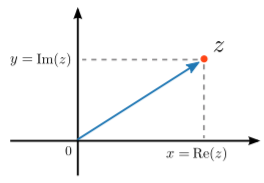4.4: The Complex Plane
( \newcommand{\kernel}{\mathrm{null}\,}\)
A convenient way to conceptualize a complex number is to think of it as a point on a two-dimensional plane, called the complex plane, as shown in the figure below. The real and imaginary parts are the horizontal and vertical Cartesian coordinates in the plane. The horizontal (x) and vertical (y) coordinate axes are called the “real axis” and the “imaginary axis”, respectively.

Polar representation
If we think of a complex number as a point on the complex plane, its position can also be represented using polar coordinates instead of Cartesian coordinates. For a complex number z=x+iy, we can introduce polar coordinates r and θ (both real numbers), such that r=√x2+y2,θ=tan−1(y/x). Conversely, x=rcosθ,y=rsinθ. These are the usual formulas for performing a change of coordinate between two-dimensional Cartesian coordinates and polar coordinates, as shown below. The radial coordinate is the magnitude of the complex number: r=|z|. The azimuthal coordinate θ is called the argument of the complex number, which is also denoted by arg(z).

Note, by the way, that the complex zero, z=0, has zero magnitude and undefined argument.
Using Euler’s formula (4.3.1), we can write z=rcos(θ)+irsin(θ)=r[cos(θ)+isin(θ)]=reiθ. Therefore, whenever we can manipulate a complex number into a form AeiB, where A and B are real numbers, then A is the magnitude and B is the argument. This is used in the following example:
Example 4.4.1
For z∈C, it can be shown that the magnitude and argument of exp(z) are: |exp(z)|=eRe(z),arg[exp(z)]=Im(z). Proof: Let z=x+iy, where x,y∈R; then ez=ex+iy=exeiy. By inspection, the magnitude of this complex number is ex, and its argument is y.
Geometrical interpretation of complex operations
Using the complex plane, we can give useful geometric interpretations to the basic operations on complex numbers:
- Addition of two complex numbers can be interpreted as the addition of two coordinate vectors. If z1=x1+iy1 and z2=x2+iy2, then z1+z2=(x1+x2)+i(y1+y2). Hence, the point corresponding to z1+z2 is obtained by adding the two coordinate vectors corresponding to z1 and z2. From this, we can geometrically prove a useful inequality relation between complex numbers, called the “triangle inequality”: |z1+z2|≤|z1|+|z2|.
- Complex multiplication can be interpreted as a scaling together with a rotation. If z1=r1eiθ1 and z2=r2eiθ2, then z1z2=(r1r2)exp[i(θ1+θ2)]. Hence, the point corresponding to z1z2 is obtained by scaling the z1 coordinate vector by a factor of |z2|, and rotating it by an angle of θ2 around the origin. In particular, multiplication by eiθ is equivalent to a rotation by angle θ.
- The conjugation operation (Section 4.2) is equivalent to reflection about the real axis. It moves a point from the upper half of the complex plane to the lower half, or vice versa.
Complex numbers have no ordering
One consequence of the fact that complex numbers reside in a two-dimensional plane is that inequality relations are undefined for complex numbers. This is one important difference between complex and real numbers.
Real numbers can be ordered, meaning that for any two real numbers a and b, one and only one of the following is true: a<bORa=bORa>b. In geometrical terms, these ordering relations exist because the real numbers reside along a one-dimensional line.
But since complex numbers lie in a two-dimensional plane, it is nonsensical to write something like z1<z2, where z1 and z2 are complex numbers. (It is, however, valid to write |z1|<|z2|, since magnitudes are real.)


